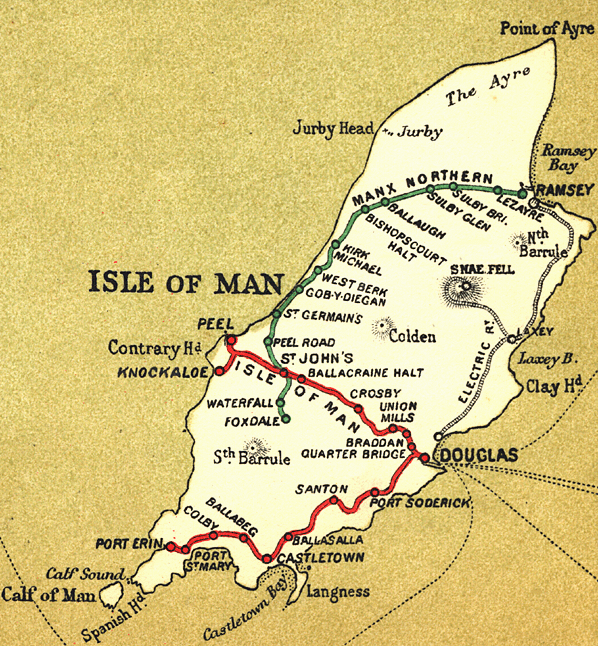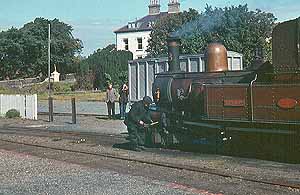
ISLE OF MAN RAILWAYS
|
| Manx Northern Railway St. John's Peel Road St. Germain's Gob-y-Diegan West Berk Level Crossing Kirk Michael Bishopscourt Halt Ballaugh Ballavolley Halt Sulby Glen Sulby Bridge Lezayre Ramsey |
Isle of Man Railway Quarter Bridge Braddan Halt Union Mills Crosby Ballacraine Halt St. John's Peel Knockaloe Foxdale Railway Waterfall Foxdale |
THE ISLE OF MAN RAILWAY COMPANY
The Isle of Man Railway Company was formed in 1870 with the intention of linking all of the islands main towns together. In order to keep costs down the company decided upon a gauge of 3ft.
 |
The company opened their first line from Douglas to Peel on the 1st July 1873. This line ran from the east to the west coast of the island and served a number of small towns and villages. Initially intermediate stations where provided at Union Mills, Crosby and St John’s. A second line was opened from Douglas to Port Erin via Castletown on the 1st August 1874. This line ran |
.
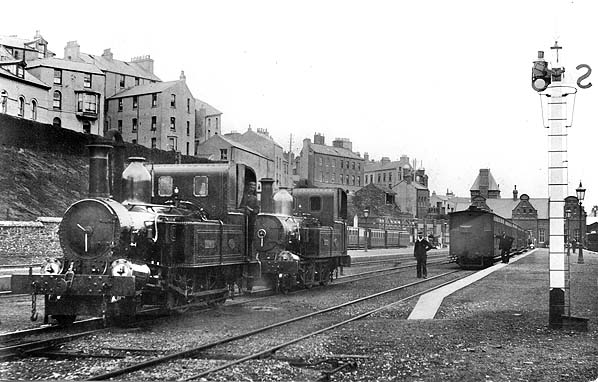 Douglas Station in the early 20th Century
Douglas Station in the early 20th CenturyCopyright photo from John Alsop collection
THE MANX NORTHERN RAILWAY
Citizens of Ramsey in the north of the island became disgruntled when they discovered that the Isle of Man Railway Company had abandoned any plans of linking up to their town. In order to progress matters a separate railway company, The Manx northern railway was registered on the 17th March 1878. The land between Douglas and Ramsey on the east coast was mountainous and so the railway to Ramsey would have to run via the west coast of the island.
| It was decided that the line would run from St John’s via Kirk Michael and Ballaugh to Ramsey. The line was opened on the 23rd September 1879 and initially intermediate stations where provided at St Germain’s, Kirk Michael, Ballaugh, Sulby Glen, Sulby Bridge and Lazayre. Connections for services to Douglas where made at St John’s where the Manx Northern had its own station just to the west of the Isle of Man Railway station. A physical connection was put in which allowed |
THE FOXDALE RAILWAY COMPANY
A group of local mine owners promoted the construction of a railway from St John’s to Foxdale to link in with the mines at that location. A company ‘The Foxdale Railway Company’ was formed to build the 2.5 mile line. The line opened on the 16th and 17th August 1886. Although primarily a freight line it was provided with passenger stations at St John’s, Waterfalls and Foxdale. From its opening the line was leased to the Manx Northern Railway who operated it.
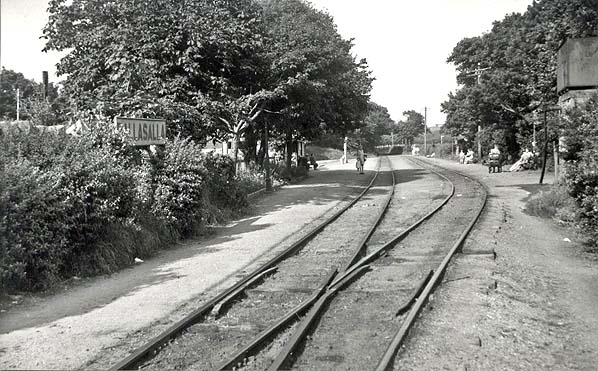
Copyright photo from John Alsop collection
COMPETITION AND TAKEOVER
In 1899 a new railway link in the form of an electric tramway opened along the east coast from Douglas to Ramsey. Operated by the Douglas, Laxey and Ramsey Railway Company the route was a serious threat to the Manx Northern Railway . At one point the new tramway company looked at buying the Manx Northern Railway but the takeover never happened. However following a Tynwald (Manx Government) investigation into the perilous state of the Manx Northern Railways finances in 1903 it was decided that the Manx Northern Railway and the Foxdale Branch that it operated should be taken over by the Isle of Man Railway. The Isle of Man Railways Act of 24th May 1905 allowed this to happen. Very shortly after the takeover infrastructure improvements where carried out to the line between St John’s and Ramsey which included strengthening two viaducts. This allowed an express service to be introduced between Douglas and Ramsey which could effectively compete with the Electric Tramway.

Copyright photo Colour-Rail
1905 – 1945
Following the creation of one railway company the Manx network grew from strength to strength with particularly heavy passenger traffic being carried during the summer months. Freight services where also very well used.
In 1911 the mines at Foxdale closed which had a huge impact on the Foxdale Branch which from that point forward so very little traffic. The passenger service was reduced to a locomotive and one coach.
 |
The outbreak of the First World War in 1914 seriously affected the holiday traffic which had topped one million in the summer of that year. However the Isle of Man was used for interring prisoners and a camp was opened close to Peel at Knockaloe. The camp was given a rail connection and provided much wartime traffic for the IOMR. |
After the war visitors once again returned to the island. Consequently the railway became very busy once again. In 1925 the railway carried 1,344,620 passengers which it would never better. However in 1926 the railway encountered serious competition from the newly created Manxland Bus Company who went into direct competition for passengers. The railway responded with a number of promotions including rover tickets. The IOMR also set up its own bus company as a separate division and caused the rival bus company to go bankrupt.
| The railway bought out the buses from the failed company and set up the Isle of Man Road Services Ltd which it operated as a means of complementing its railway operations. In 1935 the IOMR also bought the Glen Wyllin site and developed it as a visitor attraction which in turn brought more traffic to its Ramsey line as it was connected by a footpath to Kirkmichael Station. |  |
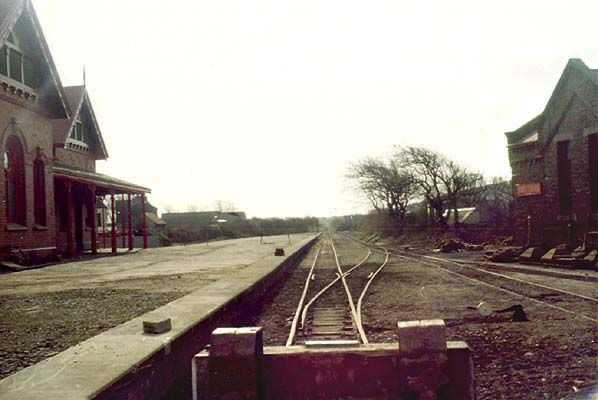
Photo:Port Erin Station in 1975 after closure of the entire network.
Photo by Jon Sabey-Corkindale
Once again war intervened and from 1939 to 1945 the island once again lost its holiday visitors. However service personnel and prisoners kept the line busy. By the end of the War over 14,000 trains had been run for the services. However during the war period in 1943 the Foxdale Branch was closed to passenger services.
Click here to continue

|
 Home Page
Home Page | Last updated: Sunday, 21-May-2017 11:31:19 CEST |
© 1998-2007 Disused Stations
|
